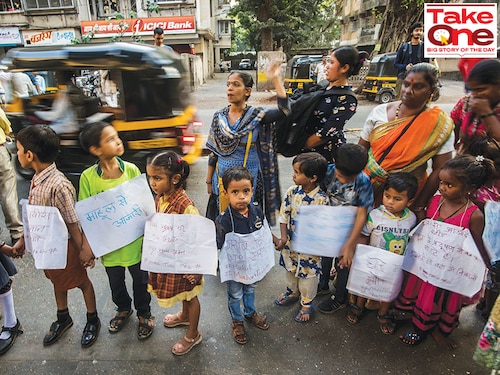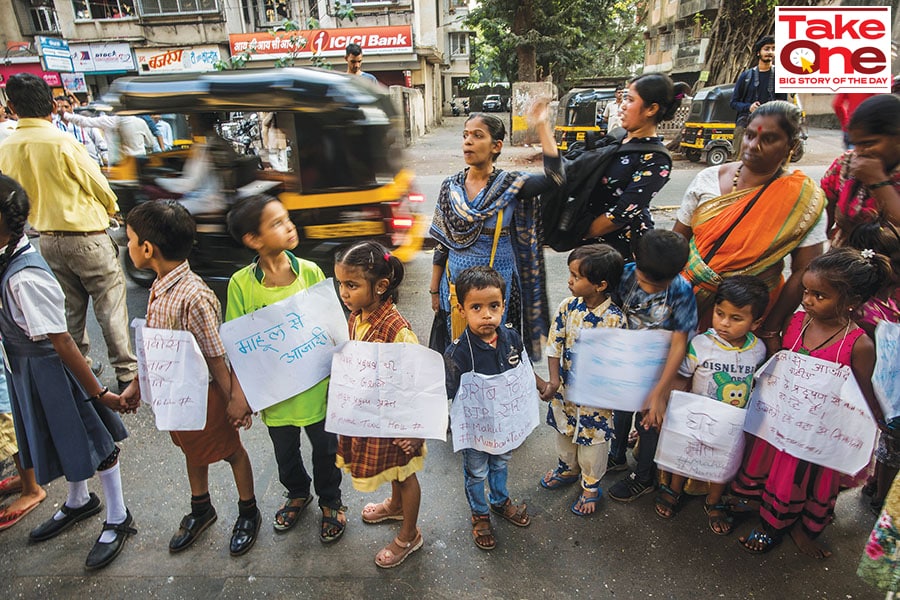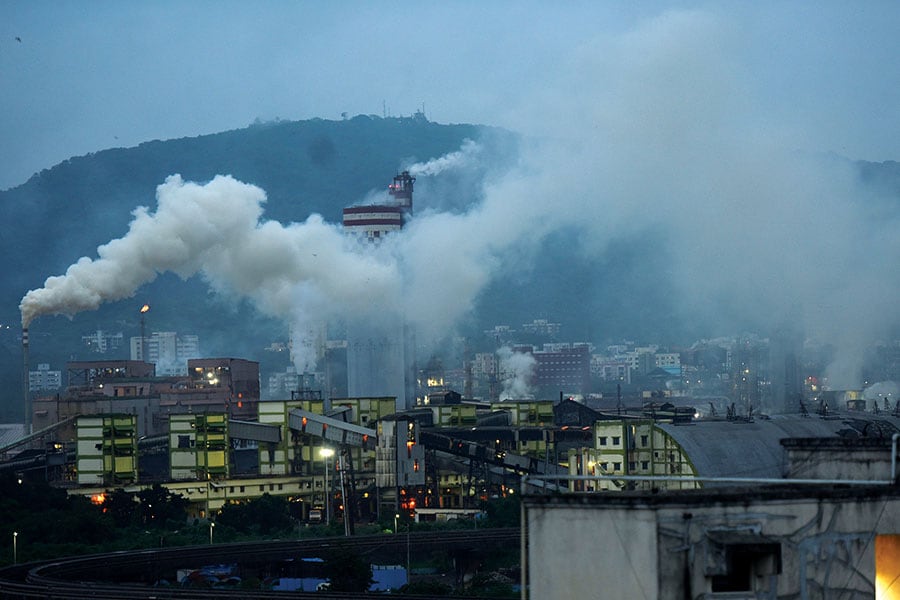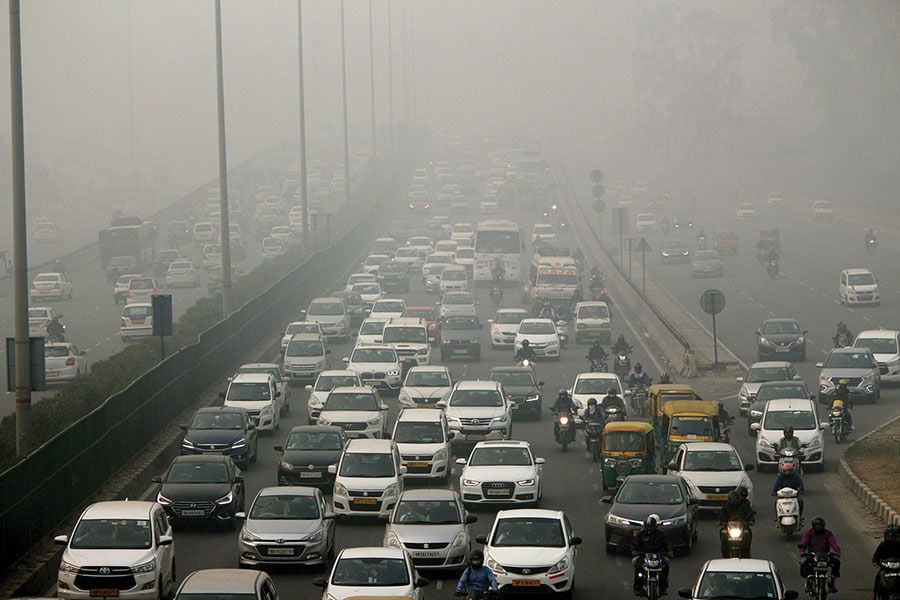Air pollution is now a matter of life and death
Until adequate measures for transformative change to prevent air pollution at source are firmly in place, Indian cities will remain highly polluted, causing illness and death, and adversely affecting


 Residents of a Mumbai locality form a human chain to protest against the government move to resettle them next to a refinery and an industrial complex. Photo: Pratik Chorge / Hindustan Times via Getty Images
Residents of a Mumbai locality form a human chain to protest against the government move to resettle them next to a refinery and an industrial complex. Photo: Pratik Chorge / Hindustan Times via Getty Images
In a dharna (agitation) which began two years ago, Anita Dhole, a resident of Mahul in Mumbai’s Chembur, continued her protest against air pollution during the coronavirus lockdown in Mumbai while most people experienced blue skies, distant, scenic views and wildlife sightings in cities all over the world, and the United Nations (UN) announced its first Clean Air for Blue Skies Day. The UN has emphasised the need to “build back better" to avoid future shocks to our planet and has described air pollution as a leading health hazard and contributor to climate change. It has also drawn attention to the special burden of climate change, including indoor and outdoor air pollution on women.
Apart from suffering from health effects themselves, women face the brunt of childcare and household responsibilities, which increase disproportionately when a family member becomes ill. Unsurprisingly, women are also at the forefront of researching data, finding solutions and creating awareness, interacting with authorities and influencing policy change.
Dhole’s 600-day dharna on the footpath from October 28, 2018, was to highlight the predicament of nearly 30,000 people, including herself, resettled next to a refinery and an industrial complex in a Slum Rehabilitation Authority project. She tells those who will listen of heartbreak and misery where children who do not meet developmental milestones because of exposure to air pollution struggle to breathe. “People are dumped next to industrial effluents and air pollution from chemicals like benzene which measure dangerously high levels and make us ill, but we feel nobody cares," she says.
ENT surgeon Dr Sarika Verma was moved to become a clean air activist when she observed that one in four children in Gurugram near Delhi (periodically the most air-polluted city in the world) has been on nebulisers and the air quality regularly crossed into hazardous levels in the winter months. “In India, 4.6 lakh people died of Covid-19 in the past 16 months, but 1.2 million people die annually from air pollution. Unlike Covid, air pollution is not treated as a health emergency to rectify a preventable cause of death," she says. Verma goes on to explain that unborn children face low birth weight and premature delivery, and there is now evidence to suggest a mother’s placenta contains breathable particulate matter of 2.5 micrometre diameter (PM 2.5).
PM 2.5 are very fine particles, a mixture of solid and liquid droplets of 2.5 diameter or smaller, 30 times thinner than a human hair. They are inhaled deeply into the lungs, causing respiratory and other disease. In Maharashtra, an Indian Medical Council Report quantifies premature air pollution deaths as 1.4 lakh people in 2019, the second highest in any state in India. Eighteen of the non-attainment air quality cities in India are in Maharashtra.
Placed within Mumbai city limits, the Deonar open landfill has been key in the recognition of the city’s air pollution problem. It contains mixed garbage unscientifically dumped to a height of 100 feet in 2016, more than 70 schools shut down for days in a blaze that could be seen on NASA images from space. People experienced the equalising nature of air pollution across socioeconomic sections as most of Mumbai was blanketed by smog and Deonar became a rallying point for air pollution-related discourse.
 Industries in Mumbai’s Mahul village spewing highly polluted air. Photo by Vijayanand Gupta / Hindustan Times via Getty Images
Industries in Mumbai’s Mahul village spewing highly polluted air. Photo by Vijayanand Gupta / Hindustan Times via Getty Images
Burning garbage dumps is ubiquitous in areas surrounding Mumbai in the absence of an effective garbage management policy and government air pollution monitoring networks do not cover them. I realised the near-complete lack of accessible data from source when I began documenting other informal garbage dumps soon afterwards. I imagined the people living alongside severely polluted air as I saw them walk alongside, white smoke billow into and around their homes.
In 2020, I measured air pollution on the roadaside in Bhiwandi with a hand-held meter next to kilometres-long burning garbage. The smell was noxious as plastic crumpled to white smoke and black shreds. The meter recorded 612µg/m3 breathable particulate matter of 2.5 diameter (PM2.5) at one-minute intervals, though the safe limit is only 20 µg/m3 in a 24-hour period. Unsurprisingly, the winter cough I already had inflamed my chest and I couldn’t speak for days. My meter, while not as accurate as the expensive air quality index stations installed by Pollution Control Boards, is highly indicative of high levels of individual exposure.
At Gurugram in 2014, software engineer and founder of Airveda, Namita Gupta, realised the lack of usable data as a mother concerned about the air her children were breathing at home. She experimented with manufacture of monitoring meters and networks meters “I set up a system to monitor air quality at home, so that I would know when I could send my children down to play, expanded it to cover their school and now supply meters to augment the government’s formal AQI monitoring network. There is no way to measure air pollution in the coverage gaps without using low-cost meters," she says.
Recently, she supplied her meters to the Maharashtra Pollution Control Board when they placed indigenously developed meters from four startups next to their stationery measuring points to evaluate accuracy of the data.
Anumita Roychowdhury and her colleagues at the Centre for Science and Environment, New Delhi, have even carried hand-held meters into the High Court and Supreme Court in 2015 to demonstrate air quality to judges.
 Heavy smog, fuelled by stubble burning in Haryana, envelopes the Delhi-Gurugram Expressway. The phenomenon has often rendered the air quality in Delhi-NCR hazardous during the season Photo: Yogendra Kumar / Hindustan Times via Getty Images
Heavy smog, fuelled by stubble burning in Haryana, envelopes the Delhi-Gurugram Expressway. The phenomenon has often rendered the air quality in Delhi-NCR hazardous during the season Photo: Yogendra Kumar / Hindustan Times via Getty Images
Prior to the Deonar fire, air pollution had been popularly understood as a ‘Delhi issue’ because of constant reports quantifying Delhi’s poor air quality. After Roychowdhury stumbled upon the issue of air pollution in the 1980s as a young researcher, she has been at the forefront of creating data and awareness and advocating policy change. Her successes include conversion of public transport vehicles from diesel to CNG, a ban on air-polluting construction activities on bad air quality days and proposal of a clean fuel strategy for industry. “Delhi is the first Indian city where the issue of air pollution was categorised into its components. Over the years, Delhi is the only city to shut down all coal power plants and the first one to ban constructions on bad air quality days. We have expanded our work to many other Indian cities too now," she says.
Following Roychowdhury’s lead, some sources have been identified and tackled in other Indian cities too. However, despite her successes, power plants in other parts of India have been granted several extensions of the deadline for clean air emissions and new coal-based power plants are still being sanctioned this year.
At a launch of the Mumbai Climate Action Plan (MCAP) in August, the energy sector (which still relies on coal fired power plants) was quantified as the largest emitter of carbon dioxide in Mumbai. In contradiction, other government agencies have categorised leading emission sources differently. Recent studies of NEERI in March 2021 and SAFAR (of the Ministry of Earth Sciences) in June 2021 point to road dust and vehicular traffic as the highest emitters respectively, with power plants, industries, open garbage burning, crematoria etc contributing significantly. While it isn’t clear which one is worst, it is certainly clear that all of these emissions require serious and sustained effort and that action is urgent.
Hema Ramani, a lawyer associated with the Bombay Environmental Action Group, has advocated for clean fuel use of the hundreds of licenced and unlicenced bakeries scattered in the residential areas of Mumbai. Her research shows that most bakeries are wood-fired. She approached MCGM to licence and regulate all bakeries within a time-bound programme for effective implementation of cleaner fuel conversions. “Unfortunately, the bakers are reluctant as there is very little interest and no incentive is being offered to them to switch to cleaner fuels by any regulatory authority," she says.
It is apt that the Clean Air for Blue Skies Day falls just before the Indian festive season and reminds us that air pollution needs to be controlled before reaching hazardous levels by taking preventive action now. The festival season worsens air quality immediately before winter, when weather conditions ensure that polluted smog hangs thickly, blanketing our cities.
Air pollution not only impacts health and climate, but the economy as well. By 2030, it is estimated that a population of more than 10 million will live in seven Indian mega cities like Mumbai, Delhi and Gurugram where air pollution is highest. GDP loss from air pollution has been quantified by the Indian Medical Council at a stunning figure of Rs7,182 crore in Maharashtra and Rs58,560 crore in India.
The National Clean Air Programme (NCAP) was launched in September 2020 as a “Long-Term, Time-Bound, National Level Strategy". It is supported by budgetary allocations of Rs4,400 crore in 2020 and Rs2,217 crore in 2021 when Finance Minister Nirmala Sitharaman in her Budget speech acknowledged the need to“tackle the burgeoning problem of air pollution".
Despite the budgetary allocation for 2020 being delayed by the pandemic and the allocation for 2021 cut by nearly half, the NCAP has given fresh impetus to action. Citizens’ experiences with clean air during the lockdown has accelerated and resulted in much greater engagement and a renewed push for transformative change.
Nevertheless, real change remains elusive. Adding to more than three million existing vehicles in Mumbai, 495 more were registered within a 24-hour period in June 2021. Stubble burning in Haryana impacts air quality of Delhi and Gurugram. Due to a rise in LPG price, poor women have returned to choolhas, burning firewood and cow dung for cooking. Wood burning crematoria, often situated in residential areas, burnt continuously and required additional firewood during the second wave of the coronavirus crisis in April-June, increasing air pollution during lockdown.
Mumbai, which recently became one of ‘Climate 40’ cities worldwide, is committed to reduce emissions by 2030 and Maharashtra will be the first state to develop a detailed climate action plan. The MCAP identifies tackling air pollution as a priority. The plan will be reviewed internally and externally through these two months (September and October), scheduled for public launch by November 2021.
Over five years after the garbage dump at Deonar burnt, we continue our struggle to identify air pollution sources. To alleviate the suffering of people like Dhole, the Maharashtra Pollution Control Board has tendered for 15 mobile air pollution vans which will identify problems and measure air pollution on the spot. In Delhi, giant smog towers are being installed in an attempt to reduce the immediate effects of highly polluted air.
However, a new IPCC (Intergovernmental Panel on Climate Change) report clarifies what is actually required as “limiting cumulative CO2 emissions". Measures such as smog towers are a palliative effort and measurement of air quality a very initial part of the long road ahead to better air quality, one which requires hard decisions.
Back at Deonar, in addition to an existing plant to incinerate medical waste, new waste-to-energy plants are proposed. Jyoti Mhapsekar, president of the Stree Mukti Sanghatana,
an NGO working with women waste pickers for decades, says many of the waste pickers they work with and the other eight lakh people who live in the neighbourhood, even people working in her office, are sufferers of air pollution. “We are apprehensive that the new incinerators for waste-to energy plants added to the already-existing medical waste plant will only increase air pollution," she says.
It’s now one year since the first UN Clean Air for Blue Skies Day. Its theme Healthy Air, Healthy Planet “emphasises the health effects of air pollution, particularly during the Covid-19 pandemic". While we quantify sources and draw up plans, we continue to encourage and promote activities which worsen air quality. Until adequate measures for transformative change to prevent air pollution at source are firmly in place, Indian cities remain among the most air polluted in the world, causing illness and death, adversely affecting our GDP and climate.
“Air pollution is a life-and-death issue for too many people," says UNEP Executive Director Inger Anderson.
Dhole’s voice is strong and clear as she tells of her harrowing experiences while distributing aid during Covid-19 to people who are already sufferers of respiratory disease caused by air pollution. “From my footpath at Mahul to thousands of people, from March 27, 2020, till today, even during the Covid wave of May-June," she says.
Women are disproportionately affected by air pollution, individually and by their burden of household responsibility. It is apt that women lead positive action too: Citizens’ science and data generation awareness campaigns, research, policy changes and startups. Inspired by them, rapidly urbanising India has the opportunity to make the air pollution story a pan-India success story. Will we step up?
(The writer is convenor, Awaaz Foundation)
First Published: Sep 07, 2021, 11:15
Subscribe Now